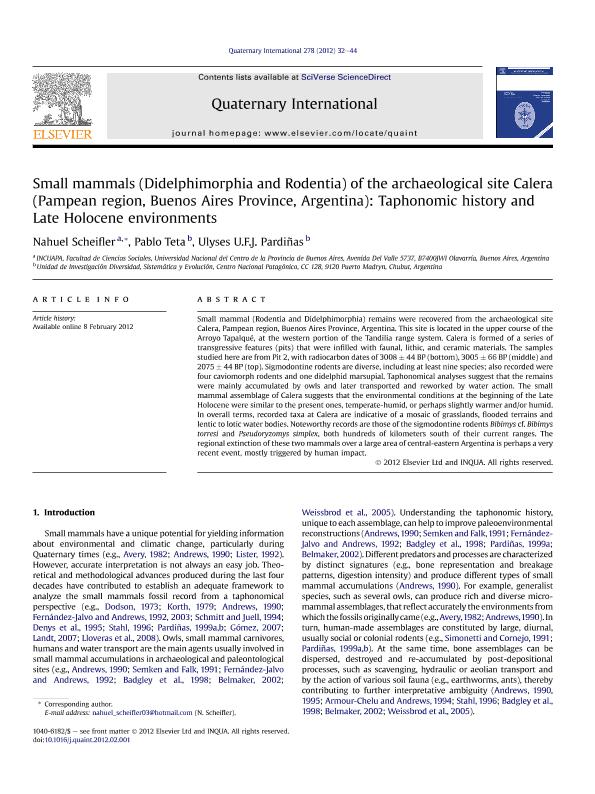Mostrar el registro sencillo del ítem
dc.contributor.author
Scheifler, Nahuel Alberto

dc.contributor.author
Teta, Pablo Vicente

dc.contributor.author
Pardiñas, Ulises Francisco J.

dc.date.available
2019-02-21T21:07:22Z
dc.date.issued
2012-11
dc.identifier.citation
Scheifler, Nahuel Alberto; Teta, Pablo Vicente; Pardiñas, Ulises Francisco J.; Small mammals (Didelphimorphia and Rodentia) of the archaeological site Calera (Pampean region, Buenos Aires Province, Argentina): Taphonomic history and Late Holocene environments; Pergamon-Elsevier Science Ltd; Quaternary International; 278; 11-2012; 32-44
dc.identifier.issn
1040-6182
dc.identifier.uri
http://hdl.handle.net/11336/70665
dc.description.abstract
Small mammal (Rodentia and Didelphimorphia) remains were recovered from the archaeological site Calera, Pampean region, Buenos Aires Province, Argentina. This site is located in the upper course of the Arroyo Tapalqué, at the western portion of the Tandilia range system. Calera is formed of a series of transgressive features (pits) that were infilled with faunal, lithic, and ceramic materials. The samples studied here are from Pit 2, with radiocarbon dates of 3008 ± 44 BP (bottom), 3005 ± 66 BP (middle) and 2075 ± 44 BP (top). Sigmodontine rodents are diverse, including at least nine species; also recorded were four caviomorph rodents and one didelphid marsupial. Taphonomical analyses suggest that the remains were mainly accumulated by owls and later transported and reworked by water action. The small mammal assemblage of Calera suggests that the environmental conditions at the beginning of the Late Holocene were similar to the present ones, temperate-humid, or perhaps slightly warmer and/or humid. In overall terms, recorded taxa at Calera are indicative of a mosaic of grasslands, flooded terrains and lentic to lotic water bodies. Noteworthy records are those of the sigmodontine rodents Bibimys cf. Bibimys torresi and Pseudoryzomys simplex, both hundreds of kilometers south of their current ranges. The regional extinction of these two mammals over a large area of central-eastern Argentina is perhaps a very recent event, mostly triggered by human impact.
dc.format
application/pdf
dc.language.iso
eng
dc.publisher
Pergamon-Elsevier Science Ltd

dc.rights
info:eu-repo/semantics/openAccess
dc.rights.uri
https://creativecommons.org/licenses/by-nc-sa/2.5/ar/
dc.subject
Taphonomy
dc.subject
Environments
dc.subject
Small Mammals
dc.subject
Late Holocene
dc.subject.classification
Historia

dc.subject.classification
Historia y Arqueología

dc.subject.classification
HUMANIDADES

dc.title
Small mammals (Didelphimorphia and Rodentia) of the archaeological site Calera (Pampean region, Buenos Aires Province, Argentina): Taphonomic history and Late Holocene environments
dc.type
info:eu-repo/semantics/article
dc.type
info:ar-repo/semantics/artículo
dc.type
info:eu-repo/semantics/publishedVersion
dc.date.updated
2019-01-14T13:27:34Z
dc.journal.volume
278
dc.journal.pagination
32-44
dc.journal.pais
Estados Unidos

dc.description.fil
Fil: Scheifler, Nahuel Alberto. Consejo Nacional de Investigaciones Científicas y Técnicas. Centro Científico Tecnológico Conicet - Tandil. Investigaciones Arqueológicas y Paleontológicas del Cuaternario Pampeano. Universidad Nacional del Centro de la Provincia de Buenos Aires. Investigaciones Arqueológicas y Paleontológicas del Cuaternario Pampeano; Argentina. Universidad Nacional del Centro de la Provincia de Buenos Aires. Facultad de Ciencias Sociales. Departamento de Arqueología; Argentina
dc.description.fil
Fil: Teta, Pablo Vicente. Consejo Nacional de Investigaciones Científicas y Técnicas. Centro Nacional Patagónico; Argentina
dc.description.fil
Fil: Pardiñas, Ulises Francisco J.. Consejo Nacional de Investigaciones Científicas y Técnicas. Centro Nacional Patagónico; Argentina
dc.journal.title
Quaternary International

dc.relation.alternativeid
info:eu-repo/semantics/altIdentifier/url/https://www.sciencedirect.com/science/article/pii/S1040618212000663
dc.relation.alternativeid
info:eu-repo/semantics/altIdentifier/doi/https://doi.org/10.1016/j.quaint.2012.02.001
Archivos asociados
